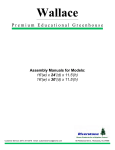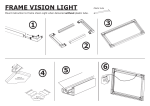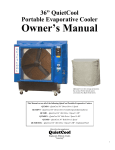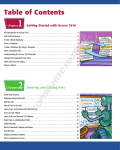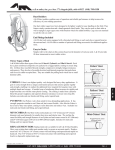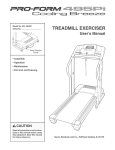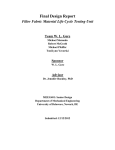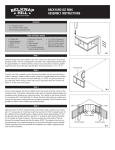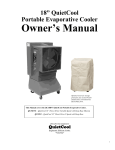Download Riverstone R12186-P Use and Care Manual
Transcript
Thoreau Premium Educational Greenhouse Assembly Manuals for Models: 12'(w) x 18'(d) x 9.5'(h) 12'(w) x 24'(d) x 9.5'(h) Customer Service: (877) 373-3078 Email: [email protected] 65 Fleetwood Drive, Rockaway, NJ 07866 FOUNDATION IMPORTANT: It is very important to begin with a level surface. Check your foundation to ensure it is level at every point. You must assure your foundation is square and level before beginning assembly. After choosing a location, proper preparation of the site is essential. The site must be level. The Scholar greenhouse can be mounted two ways: on concrete slab or concrete footer. 12'- 8'' 4'' from edge 4" from edge gray dashed lines = groundrails for greenhouse END VIEW OF TYPICAL CONCRETE SLAB 4'' slab 3'' 24'-10'' OVER HEAD VIEW concrete slab turndown varies 45° 3'' rebar continuous at perimeter laps a minimum of 25'' with 4 ties evenly spaced 12'' ground rails When pouring concrete slab be sure to make the slab 10'' longer and 8'' wider than your order size. An example is shown above: OVERHEAD VIEW concrete slab shows a greenhouse order for a 12' x 24' Scholar. The slab is poured 12'-8''wide and 24'-10'' long. Set front/rear groundrails 4'' inward from edge of concrete and side groundrails are set 4'' inward from edge of concrete. 12'' Groundrails will also be set the same on footer as on concrete slab FOOTER 12'' 12'' 3" Width (plus 8'') turndown varies 3'' ground rails Length (plus 10'') Page 1 rebar continuous at perimeter laps a minimum of 25'' with 4 ties evenly spaced GROUNDRAIL ASSEMBLY 1. Identify groundrail components: 1 front groundrail, 1 rear groundrail, 2 side groundrails or side rails * front & rear groundrails will be identical in appearance * 2. Locate "L" brackets for groundrails and install them onto the inside of the groundrails at every welded stanchion and 3'' to 4'' from the corners on the side groundrails. see below illustration SIDE GROUNDRAIL welded stanchions GROUNDRAIL "L" BRACKETS FRONT/REAR GROUNDRAIL stanchion for 2'' x 2'' Leg stanchion for 2'' x 2'' Leg TOP AIL NDR ROU OF G F L P O AI TO NDR OU GR '' 3''- 4 OF IL IDE RA INS UND O GR GROUNDRAIL "L" BRACKET #14 tek screws Page 2 GROUNDRAIL ASSEMBLY cont'd 3. 4. Connect the front & rear groundrails to the side groundrails, all "L" brackets should be facing toward the inside of your greenhouse. see Detail A * Make sure groundrails are "square" before securing to foundation* Secure connected groundrails to foundation see Detail B. front/rear groundrails side groundrails u eq ea al m s ts en m ure side groundrails front/rear groundrails #14 tek screws to attach front/rear groundrails to side groundrails welded stanchion for leg Detail A DETAIL B. front/rear groundrails side groundrail 1 2" x 5 21" concrete anchor bolts Page 3 1. 2. 3. RAFTER ASSEMBLY NUTS #14 x1'' TEK SCREWS 1 4" 5 16" NUT BOLT HOLE for RIDGE EXTRUSION 1 1 4" x 2 4" U- BOLT PURLIN HANGER "L" BRACKET (aluminum) Purlin Hanger "L" brackets MUST be facing the inside of the greenhouse on END BOWS. Purlin Hanger "L" brackets on Intermediate bows can be placed on either side of the rafter. CENTER CONNECTOR Identify rafter/bow parts (refer to packing slip for specific quantities of each part) Attach "L" brackets to half bows as shown below for a 12' wide greenhouse. Slide half bows onto center connector and secure with #14 x 1'' tek screws. Attach U-bolts to each "L" bracket using 41" nuts - do not tighten at this stage. HALF BOW (66 21") 2'' X 2'' HALF BOW x 2 21" CARRIAGE BOLT 5 16" Page 4 Sidewall & Roof Assembly 1. intermediate legs Identify legs for sidewalls: 2'' x 2'' square tubing, quantity depending on order (refer to packing slip) The length of the legs depend on the sidewall height of your order. A sidewall height of 5'-0'' will have legs 58'' long, so the legs will measure 2'' shorter than the ordered sidewall height. side groundrails VIEW AT INTERMEDIATE LEG VIEW AT CORNER 2. Place legs on groundrail stanchions and secure using #14 tek screws corner legs #14 tek screw 3. After attaching legs to the side groundrails, identify brackets named: Corner Bow to Column Brackets & Intermediate Bow to Column Brackets 1'' flat bar corner column bracket profiles 4. intermediate column bracket profile Insert the brackets into the top of the legs, let the 1'' flat bar rest on the lip of the leg as shown below. Note on the corner brackets, the 1'' flat bars have to be facing each other as indicated in corner bracket profiles. Take the assembled rafters and slide them onto the column brackets and secure working from the inside of the greenhouse using #14 tek screws as shown in detail A. 5. corner bracket holes are facing each other end rafter #14 tek screw attaching rafter to column bracket corner leg line indicates lip of leg intermediate leg corner leg column bracket leg detail A Page 5 #14 tek screw attaching column bracket to leg 2'' X 2'' TRUSS CHORD DETAIL for Scholar with 8' sides 1. 2. 3. 4. 5. 6. Identify truss chord (2''x 2'' x 11'-8'') Attach L brackets flush with the ends of the truss chords detail A. With the truss chord L brackets facing down toward the ground, attach truss to the top of the legs detail B. Truss chords are to be placed only on the intermediate rafters. Identify truss uprights (1 38" x 47'') Secure one end of the upright using supplied bolts to the pre-punched holes on the truss chord (2x2). Attach the opposite end of the upright to the rafter, at the pre-punched hole nearest the center connector. Only Intermediate Legs will have trusses detail A. TRUSS CHORD (2''X 2'') RAFTER L BRACKET detail B. L BRACKET LEG TRUSS CHORD(2X2) uprights 2x2 truss chord Completed Intermediate Rafter w/ Truss & Uprights Page 6 Sidewall & Roof Purlin Sidewall Horizontal Purlin (2'' x 2'' square tubing) will need to be cut into 70'' pieces, this should be the distance between each leg. Before cutting, measure from inside to inside of each leg to make certain that this is your measurement. roof purlin 2''x 2'' sidewall horizontal purlin 2'' x 2'' sidewall horizontal purlin purlin 70'' 5' sidewall = 29" 6' sidewall = 35'' 8' sidewall = 47" legs side groundrail 1. 2. leg Depending on sidewall height ordered, measuring up from the top of the groundrail place purlin at 29'' for 5'-0'' sides or 47'' for 8'-0'' sides. Attach purlin to legs using 3'' x 3'' L brackets & #14 tek screws see detail B. 3x3 L bracket #14 tek screws detail B PREPARING of ROOF PURLIN Identify 1 3/8" x 12'-5'' purlin with swedge. 1. connect the appropriate number of purlin together to equal the length of your greenhouse see detail C. You may have excess, you will cut it off at a later time. 2. Next, lay the connected purlin, on the ground flush with the end of the side groundrail see overhead view of corner. 3. Make a mark 2'' from the end - this represents the width of the leg on the purlin. Then move down and mark one side of the intermediate leg (on the purlin) and then the other side of the leg (on the purlin) 4. Repeat this process for the length of the structure and all runs of purlin. roof purlin see detail C. groundrail purlin detail C. line-up mark for rafter line = purlin flush w/ end of groundrail purlin (male end) purlin (female end) Overhead View of Corner tek screw Page 7 Roof Purlin cont'd When installing roof purlin start from the front or rear and slide the purlin through the U-bolts on the purlin hanger "L" brackets that are already attached to the rafters. 5. Flush one end of the purlin with the End Rafter (front or rear) using the marks that you made on the purlin, line up the back side of the rafter and tighten u-bolt on to the purlin. 6. Move to the next rafter, using the marks on the purlin, line up the rafter and tighten u-bolt onto purlin. 7. Repeat this process for the remaining runs of purlin. Individually tightening u-bolts as you go and keeping the 70'' distance between each rafter 8. Cut off any excess roof purlin flush with end rafter end rafter Page 8 roof purlin Installing Eave Extrusion Eave extrusion is an aluminum channel that receives both the roof and sidewall polycarbinate sheets. Aluminum Eave Extrusion SIDE PROFILE Eave Extrusion channel for roof polycarbinate bolt track attaches to column brackets channel for sidewall polycarbinate column-to-rafter bracket (corner) eave extrusion end rafter 1. 2. 3. 4. 5. 6. Identify Eave Extrusion. Slide 1/4" x 3/4" stainless steel bolts into the bolt track, for proper bolt quantity, count the holes in the bow-to-column brackets. Flush eave extrusion with end of the corner leg Align the bolts with the holes in column-to-rafter brackets and apply 1/4" stainless steel nuts To splice two pieces of Eave Extrusion, use 2'' x 6'' aluminum splice plates. At the end of the first piece of Eave Ext. add two 1/4" x 3/4" bolts also add two bolts at the start of the second piece. Apply aluminum splice plate and secure with 1/4'' nuts. Repeat process for opposite side. eave extrusion intermediate rafter eave extrusion piece #2 eave extrusion piece #1 1 21" x 12'' aluminum splice plate 1/4" s.s. nuts s.s bolts Page 9 Framing Endwalls Endwall studs will be pre-cut. Door headers, Door studs and horizontal purlin will have to be field cut. Refer to the page(s) labeled Endwall Layouts for proper placement and measurements of your purlin & door studs. The illustrations below show connection details for attaching door studs to the groundrail and rafter, also the proper placement of "L" brackets when framing an opening for a door or fan. REAR ENDWALL FRONT ENDWALL endwall horizontal purlin L bracket SIDEWALL HEIGHT door header 2. door or endwall studs fan/shutter opening fan/shutter opening WIDTH 1. 1. gre ide ins se ou enh tek screw thru door stud & stanchion 2'' x 2'' door stud 2. 1.install front/rear door studs over the welded stanchions and secure using #14 tek screws rafter welded stanchion purlin zontal hori 2''x6'' flat bracket ill dra n u gro e se sid out enhou gre 2. view from inside and at the end rafter. Connect the endwall studs to the rafters using 2x6 flat bracket and #14 tek screws endwall/door stud IF YOUR GREENHOUSE HAS AN EVAPORATIVE COOLING SYSTEM refer to the Endwall Layout (rear endwall w/ evaporative cooling system) page Page 10 In the next page(s) you will see typical Endwall Layouts for the "Scholar Series" greenhouse. Look these drawings over carefully, if you do not have a typical endwall layout you will receive a special drawing separate from the instruction manual with your endwall configuration. Frame out measurements are provided for equipment - fans, shutters and doors that Atlas Manufacturing offer. We recommend identifying your specific equipment sizes before starting the process of framing the endwalls. Some endwall layouts will show framing out for Evaporative Cooling Systems. This is for endwall framing only, actual step by step instructions are in (2) separate booklets. Page 11 frame-out for fan 2'-521" frame-out for fan 5' ENDWALL LAYOUTS frame-out for door 12' 8' (FRONT ENDWALLS) 2'-8" frame-out for fan 2'-721" 3'-3" frame-out for door 12' If you have another door and shutters your Rear Endwall Layout will be the same as shown here. see OPENING MEASUREMENT for FANS, SHUTTERS and DOORS page for equipment openings 2'-8" frame-out for fan Page 12 3' x 10' Evaporative Cooling System 3'-2" 2'-10" 2'-021" 2'-521" 10' frame-out for shutter 12' 8' 3'-10" 2'-2" 4' x 10' Evaporative Cooling System ENDWALL LAYOUTS 1'-4" 12' 10' 5' 1'-4" 1'-4" 10' 12' 5' x 10' Evaporative Cooling System 4'-10" 1'-4" 12' 10' - ALL FRAMING MATERIAL = 2'' x 2'' SQUARE TUBING - REFER TO "OPENING MEASUREMENTS FOR FANS, SHUTTERS AND DOORS PAGE'' FOR EQUIPMENT FRAME-OUT SIZES 2'-10" 8' 3' x 10' Evaporative Cooling System (REAR ENDWALLS) 5' 1'-4" 12' Page 13 exhaust fan Sidewall Door Mounting If your Scholar has 8' sides and an Evaporative Cooling System in the endwall, you will need to mount the rear door in the sidewall of the greenhouse as seen below . SIDE VIEW OF GREENHOUSE door header door stud horizontal purlin Refer back to Framing Endwalls page for door framing instructions. wall vent (cooling system) Page 14 OPENING MEASUREMENTS FOR FANS, SHUTTERS AND DOORS {SUPPLIED BY ATLAS} Fan opening for: 18” Box wall “Quietaire” 30” Slant wall “Quietaire” 36” Box wall “Quietaire” 36” Slant wall “Quietaire” 42” Slant wall “Quietaire” 48” Slant wall “Quietaire” 56” Slant wall “Quietaire” 24 1/2” High X 24 1/2” Wide 35 5/8” High X 34 3/4" Wide 40 1/2” High X 40 1/2” Wide 42 1/4" High X 41” Wide 48 1/2” High X 47” Wide 54 1/4” High X 52 3/4” Wide 65” High X 63” Wide Shutter openings for: 24” Shutter 30” Shutter 39” Shutter 45” Shutter 48” Shutter 60” Shutter 24 1/2” Square 30 1/2” Square 39 1/2” Square 45 1/2” Square 48 1/2” Square 60 1/2” Square Door openings for: 42” X 6’6” Swing door 4’ X 6’8’’ Swing Door 36” X 6’8” Swing door 6’ X 6’8’’ French Door 4’ X 7’ Single Sliding door 8’ X 7’ Double slide door Set openings 42 1/2” Wide X 78 1/2” High Set openings 48 1/2” Wide X 80” High Set openings 36” Wide X 80” High Set openings 72” Wide X 80” High Set openings 46” Wide X 82” High Set openings 96” Wide X 82” High NOTE: Measurements are inside to inside. If you have purchased an evaporative cooling system, please refer to those instructions now for frame openings and end wall layouts. All of the above listed items may not be available for your particular structure. Page 15 INSTALLING HEATER HANGER heater hangers front end rafter HEATER HANGERS MUST BE BEFORE COVERING END WALLS INSTALLED place tek screw here after final alignment end rafter field drill hole heater hanger heater hanger cannot extent past end bow or damage to end wall covering will occur field drill hole heater hanger bracket -slides to inside of end rafter and second rafter -secure using bolts and nuts provided Attach the heater hangers to the end rafter (preferably to the front end rafter) and the second rafter. Be sure that the heater hanger does not extend past the end rafter because it will damage the end wall covering when it is installed. Bolt holes for the heater hanger brackets are to be field drilled into the rafters. IMPORTANT: insert the bolts from the outside of the greenhouse. If inserted from the inside, it damage end wall covering. After you are comfortable with the placement of the heater hangers, secure the heater hanger brackets to the heater hangers using a tek screw. This step will insure that the heater hanger will not slide out of place when hanging your heater. Page 16 VENT PIPE KIT FOR NON-POWER VENTED HEATERS PARTS GENERALLY REQUIRED 1- ADAPTER FOR DOUBLE WALL PIPE 2- WALL COLLARS 1- ADJUSTABLE ELBOW 1- VENT STACK LOT- PCS. DOUBLE WALL PIPE 10'- METAL STRAPPING (WALL BANDS) CAP 1' MIN. HEATER HANGER 4' PIECE PIPE ANGLES DOWNWARD 1" TO 2" ADAPTER 2-PIECE ELBOW HEATER DRILL WEEP HOLES IN BOTTOM OF ELBOW 18" MIN. WALL COLLARS END BOW Page 17 HEATER VENT PIPE FOR A POWER VENT HEATER PARTS GENERALLY REQUIRED With a power vent heater it is not necessary for the vent stack to be above the roofline. 2- WALL COLLARS 2- ADJUSTABLE ELBOW 1- VENT STACK 2- 1'PCS. DOUBLE WALL PIPE HEATER HANGER VENT STACK ADAPTER HEATER ADJUSTABLE ELBOW PIPE ANGLED DOWNWARD 1" TO 2" DRILL WEEP HOLES IN BOTTOM OF ELBOW 18" MIN. WALL COLLARS END BOW Page 18 Aluminum Base Angle 1. 2. Identify the 2''x 3'' Aluminum Base Angle (ABA). Place ABA against the side groundrails (3'' down 2'' up) Aluminum Base Angle base angle profile 2" ABA 3" 3. Slide the ABA past the end of the groundrail 3''. Mark on the 2'' side of the angle where the groundrail ends and cut 2'' side on the line. The 2'' side of the ABA will be flush with the groundrail, and the 3'' side will hang past the groundrail 3''. side groundrail 3. cut line 3'' side groundrail 4. detail A. rear groundrail corner leg side groundrail corner leg ABA 3" hang front groundrail er ov o 4. 3" 2'' 3" hang ABA r ve angle end to end After notching the initial piece of ABA, continue placing angle end to end down the side groundrail. Repeat notching process at opposite end of greenhouse. *Remember* when cutting ABA at opposite end of greenhouse, DO NOT cut the ABA flush with groundrail. Cut 3'' longer than groundrail and notch the 2'' side back 3'' see detail A. Lay ABA across the front & rear of the greenhouse. Place a piece of ABA against the 3'' over hang at the corner of greenhouse. Make sure that the ABA is held against the front groundrail, mark the ABA at the door stud and cut off flush with the inside edge of door stud see 5a. Repeat for opposite side of door and rear of greenhouse. If you do not have a door in the rear of greenhouse, lay ABA end to end to equal the width of the greenhouse. 5. 5a. door opening 5. ABA flush against 3''overhand door stud endwall stud front groundrail Page 19 corner leg red = ABA cut flush with door stud 1 Using a metal cut bit, drill a 5/16" hole approximately every 18'' apart down the length of the ABA. (Photo 1) 2 Next use a 1/4" masonry to drill the holes into the concrete footer approximately 3" deep. (Photo 2) 3 Insert the 1/4" drive pins into the holes and anchor the ABA to the concrete using a hammer as shown in photo 3. Simply butt the 10' lengths end to end, until the perimeter of the greenhouse is complete. Do not attach the ABA to the column post or leg using Tek-screws; the screw heads will interfere with the P.C.S.S. covering. ONLY USE THIS METHOD OF SECURING "ABA" IF YOU HAVE A CONCRETE SLAB OR CONCRETE FOOTER. VIEW AT THE CORNER Page 20 Installing Ridge Base ridge base extrusion The ridge base extrusion will attach to the peak of the greenhouse at each center connector. 1. 2. 3. 4. Identify the Ridge Base Extrusion (12'-0'' in length) Identify and locate 1/4'' x 2 -1/2" stainless steel bolts & nuts for ridge extrusion. Slide three bolts into the bolt track of the initial piece of ridge base Take ridge extrusion and place the bolts into the pre-punched holes at the top of each center connector. At the end rafter, flush the ridge base extrusion with the outer face of the center connector. When flush, apply washer & lock nut. Do not tighten bolts at this point. 4. 3. bolt track center connector ridge base extrusion ridge base flushed w/ end of center connector 1 4" x 2 21" stainless steel bolt 5. 6. ridge base profile washer lock nut Connecting additional pieces of ridge base, identify Aluminum Splice Plates. Slide (2) additional 1/4'' x 2-1/2" bolts into the bolt track at the end of the already installed piece of ridge base, place the splice plate onto those bolts, apply washers & lock nuts and firmly tighten splice plate to ridge base. Repeat steps 4. & 5 until installation of ridge base is complete CONNECTING RIDGE BASE EXTRUSION Aluminum Splice Plate (1 21" x 12'') 5. 1 4" stainless nuts 1 4" x 34" stainless steel bolts Page 21 Installing Ridge Cap ridge cap The ridge cap extrusion will attach to the ridge base extrusion forming a channel to receive and hold the polycarbinate in place at the peak of the greenhouse 1. 2. 3. Identify Ridge Cap Extrusion Place on top and flush with the end of the ridge base. Secure with one #14 x 3" tek screw approximately 2'' from end, then every 4'-0'' apart. 2. 1. #14 x 3'' tek screw w/ washer ridge cap approx. 2'' ridge base 3. +/- 4'-0'' +/- 4'-0'' Page 22 ATTACHING THE INTERMEDIATE RAFTER EXTRUSION 1 Ridge Base Rafter Extrusion Hip Begin by measuring from the hip of the ridge base extrusion down to the edge of the eave extrusion along the top of the rafter. Use the measurement to cut the intermediate rafter extrusion to the appropriate length. (Ridge cap will already be attached at this point but not shown in photo #1 to help better explain how to install the intermediate rafter extrusion). Starting at the top, lay the Intermediate rafter extrusion over the flange of the ridge base extrusion allowing the tek-screw in the ridge base extrusion to fit inside the slot located on the underside of the intermediate rafter extrusion. (See photo #1 & Fig. E). Ridge Base Flange Be sure that the Intermediate rafter extrusion is pushed up against the hip of the ridge base extrusion and insert two tek-screws through the Intermediate rafter and through the flange of the ridge base extrusion. (See photos 1 - 3 & the drawing @ the bottom of this page). 2 3 Working your way down, conform the Intermediate extrusion to the shape the rafter, while inserting two tek-screws 12 to 16 inches apart down the full length of the rafter. (See all photos). 4 Intermediate Rafter Extrusion Fig. E Two tek-screws side by 5 Intermediate Rafter Extrusion Tek-screw Attaching Ridge Base Intermediate Rafter Eave Extrusion Page 23 6 COVERING ENDS WITH P.C.S.S. USING H-SPLICE IMPORTANT: Be sure to read the label on the P.C.S.S. covering to determine the side of the sheet that should face the sunlight (outside). Remove the protective film, just before attaching each sheet. IMPORTANT: Identify the sheets for the end walls and be sure to use them correctly. Depending on the width of your greenhouse, you should have 3 or 4 different length sheets for each end. The shorter sheets will be used at the corners and increase in length as they near the center of the house. MARKING THE BACK OF THE SHEET TO REMOVE EXCESS FROM FAN OPENING. FAN OPENING 1 Begin with the first sheet flush with the outside corner. Be sure the sheet is vertically level and in its proper location. Trace out any door, fan or shutter openings on the backside of the sheet and remove the excess using a skill saw. (See photos 1& 2) Stand the P.C.S.S. in place and attach it the end wall framing using the #12 x 1-1/2" tek-screws with the oversize washers provided. The screws will need to be spaced approximately 18" apart. 2 When joining two sheets together, you must attach a piece of H-splice after each sheet across the width of the house. Goes Against the Frame H-SPLICE The H-splice attaches to the endwall framing using the #12 x 1-1/4" tek-screws provided. (The outside corners do not get H-splice). Note: The small groove down the center of the H-splice, must face the outside. This is the screw groove. (See photos 3 & 4) Allow the excess sheeting and H-splice to extend above the 2"x 3" end rafter as you complete the endwall, then remove the excess above the rafter using a sawzall or jigsaw. (See photo 5) Screw Groove Excesss 3 H-SPLICE FITS OVER ALUMINUM BASE ANGLE (ABA) INSERT TEKSCREW THROUGH THIS Groove ABA 4 5 Page 24 6 ATTACHING 1'' X 1'' ANGLE AROUND FAN AND SHUTTER OPENINGS Measure the bottom of the opening and notch the 1" x 1" angle leaving 1" extending beyond the opening on both ends. (See photo 1) Slide the angle into the opening and attach it from the outside using the # 12 x 1" tek-screws provided as shown in photos 2 & 3. Repeat these steps for the top of the opening. 1" Notch 1 2 3 On the side of the opening measure and notch the angle on both ends as shown in photo 4. 1" Notch 4 Using this 45 degree notch will dress up the looks of the opening but is not required. If you would rather use the same notch used on the top and the bottom pieces, this is perfectly acceptable. Slide the angle into the opening allowing it to lap over the extended portion of the top and bottom pieces and attach it from the outside using the # 12 x 1" tek-screws provided as shown in photos 5 & 6. If the H-splice extrusion on your endwall, falls out beside the fan opening as shown in photo 7, you will not use 1" x 1" on this side. IMPORTANT: The 1" x 1" aluminum angle is intended to be used around the fan and shutter openings only. For more Information on 1" x 1" Angle 5 H-Splice 6 7 Page 25 ATTACHING END RAFTER EXTRUSION Apply foil tape to the top of the end rafter, allowing it to over-lap the top edge of the P.C.S.S. endwall covering. This prevents moisture, caused by condensation from collecting between the two layers of the P.C.S.S. covering. (See photo #1) Foil Tape Note: Before attaching the end rafter extrusion, be sure the ends of the ridge base extrusion are covered with foil tape. 1 End Rafter Extrusions P.C.S.S. Ridge Cap Ridge Base Starting at the top, lay the end rafter extrusion over the flange of the ridge base extrusion making sure that the lip is turned down lapping the P.C.S.S. endwall covering. Butt the end rafter extrusion up to ridge base extrusion and insert two screws into the end rafter extrusion, through the flange of the ridge base extrusion as shown in photo #2. (Also see Fig. F) Note: The groove under the end rafter extrusion is not large enough to except the tek screw in the ridge base flange as was with the intermediate rafter extrusion. Lip Fig. F Flange 2 End Rafter Extrusion Lip End Rafter 3 Eave Extrusion Twin Wall ( P.C.S.S.) Working your way down, conform the extrusion to the shape of the rafter, while inserting two tek-screws 12 to 16 inches apart down the full length of the rafter. (See photo #3) Cut off the excess, making sure that the end rafter extrusion stops flush with the edge of the eave extrusion. (See photo #4) End Rafter 4 Page 26 COVERING THE SIDEWALLS H-Splice Screw Groove Goes against Measure and cut the H-splice to fit between the Eave Extrusion and the Aluminum Base Angle. The H-splice overlaps the top of the ABA as shown in photo #2. The H-splice attaches to columns through the screw channel using the 5/16" x 1-1/4" teks-screws approximatley 15" apart. Only attach the first H- splice. The corners Will Not get H-splice. Fig. G Measure from the ABA up to the top of the eave extrusion wall channel and subtract 1/4". Cut the lengths of the P.C.S.S. using a Jig-Saw or Sawzall. (Fig. G) 1 Screw ABA 2 Eave Extrusion 1/4" Measure Cut Eave Extrusion Wall Channel P.C.S.S. Wall Covering P.C.S.S. ABA Helpful Hint: Stack 3 to 4 sheets of P.C.S.S. on top of one another. Flush the ends of the sheets and cut all at one time to the required length. Be careful and be sure that the measurements are correct before cutting. Consider wearing eye and ear protection while cutting. H-splice With the first piece of H-splice in place, insert the first sheet of P.C.S.S. upward into the eave extrusion channel and slide the sheet sideways until it is completely seated into the H-splice Channel. (See photo 3) Note: The P.C.S.S. may have up to 3/16" of slack in the H-splice or the eave extrusion channel. This is O.K. 3 2nd Sheet 5/16" x 1-1/4" Tek-screws Approx. 18" Apart 4 Peal off the protective film and attach the P.C.S.S. sheeting to the ABA and the sidewall horizontal purlin using the 5/16" x 1-1/4" tek-screws approximately 18" apart. Be sure that the correct side of the sheet is facing outward. Repeat the procedure for the second sheet by inserting the sheet upward into the eave extrusion first then sliding the sheet over into the H-splice channel. Now slide the H-splice on the opposite end of the sheet and attach it to the column post using the 5/16" x 1-1/4" tek-screws. Attach the P.C.S.S. to the ABA and the sidwall horizontal purlin using the 5/16" x 1-1/4" tek-screws also. (See photos 4 & 5) Continue this procedure until you reach the end. Repeat the procedure for the opposite side of the house. Last Sheet Insert Here First Slide H-splice On Last 4 5 6 Page 27 ATTACHING 1" X 1" ANGLE AROUND BASE Identify and attach the 1"x 1" aluminum angle. This 1" aluminum angle lies over the 2" x 3" Aluminum Base Angle (ABA) and against the P.C.S.S. at the base of the structure. Attach using 5/16" x 1-1/4" tek-screws approximately 24" apart. 1" x 1" Lap each section of 1" x 1" approximately 2" to 3" as you continue around the perimeter of the structure. Use the same process for notching the corners as you did with the 2" x 3" ABA. 2" x 3" 5/16" x 1-1/4" Tek-Screws Approximatley 24" Apart 2" to 3" Lap 1" x 1" Base Angle 2" x 3" Base Angle Page 28 ATTACHING THE CORNER FLASHING Applying the corner flashing Identify the 2" x 3" aluminum flashing (the same as the base angle we used earlier) Using tin snips or a jig saw, cut the corner flashing to length and trim the top end to fit as neat as possible. 1 Attach the corner trim using Tek-Screws with washers. 3 2 Page 29 INSTALLING P.C.S.S. ROOF COVERING After all extrusions are in place, snap the P.C.S.S. support brackets onto the purlins. Each purlin will receive (3) support brackets between each rafter as shown in photos 1 & 3. Let the P.C.S.S. support brackets hang upside down and out of the way until you get the P.C.S.S. roof panels in place. (See photo 1) IMPORTANT: Remember to check the label and place the proper side of the P.C.S.S. toward the sun. P.C.S.S. Support Brackets In The Down Position. 1 Slide the first sheet of P.C.S.S. onto the roof and between the ridge base and the ridge cap extrusions. The P.C.S.S. sheets will be a few inches too long. Be sure that the sheet is pushed all the way up before cutting. (See Fig. H) While holding the P.C.S.S. in place, make a mark 1/2" up from the bottom of the eave extrusion roof channel. (See Fig. I) This is the only way to be sure the P.C.S.S. will be the proper length. It is not necessary to place the sheet on a saw horse. Slide the sheet downward a few inches and cut using a skill-saw or jigsaw. Now slide the sheet back up between the ridge base and ridge cap, slightly buckle the sheet upward and allow the sheet to fall into the eave extrusion channel. USE EXTREME CAUTION WHEN CUTTING THE P.C.S.S. 2 3 After each roof panel is in place, flip the P.C.S.S. support brackets up and insert a #12 x 1-1/2" washer tek-screw through the P.C.S.S. covering and into each of the support brackets. Be careful, over tightening the screws will damage the covering. There should be (3) support brackets between each rafter. (See photo 3 & 4) P.C.S.S. Roof Covering P.C.S.S. Support Brackets In The Up Position. 1/2" 4 Ridge Base Extrusion Cut mark #12x3" WASHER TEK SCREW Eave Extrusion Roof Channel Ridge Cap Extrusion P.C.S.S. Roof Covering The P.C.S.S. roof panels should be pushed all the way up to get a true cut length. P.C.S.S. Sidewall Covering Fig. H Page 30 Measure from this point of reference Fig. I INSTALLING P.C.S.S. ROOF COVERING (CONT'D) At the end rafter and on the intermediate extrusions between each roof panel, you will need to attach a piece of aluminum cap. Lay the cap in place and Screw into place using#12x2" washer teks on all end rafters and #12x1" washer teks on intermediate rafters approx. 36" apart WASHER TEK SCREW 1 END RAFTER Fig. J PEAK CAP SNAP CAP P.C.S.S. P C S S 2 Fig. K INTERMEDIATE RAFTER SNAP CAP P.C.S.S. 3 P.C.S.S. If theAluminum cap extends beyond the edge of the house, remove the excess by cutting it flush with the outside edge of the eave extrusion using a hack-saw. (See photo 3) 2- TEK-SCREWS PEAK CAP Finish off the end walls by capping each gable end peak, using a peak cap. Allow the 1-1/2" flange of the peak cap to slide between the end rafter extrusion and the snap cap until the peak cap is lying flush against the end wall. Center the peck cap and insert two #12 x 2" washer tekscrews through the aluminum cap, the peak cap and into the end rafter extrusion. (See the above photo & Fig. J) VERY IMPORTANT: Once all the P.C.S.S. roof panels have been installed, you must insert a tek-screw through each of the P.C.S.S. support brackets into the purlins. Failure to do so, could result in structure failure in severe weather conditions. Page 31 HAF FAN INSTALLATION USE THE CHAINS PROVIDED TO ATTACH HAF FANS DIRECTLY TO THE BOW ASSRMBLY OR TRUSS CHORD. USING TEK SCREWS,SCREW THE CHAINS DIRECTLY TO THE SIDE OF THE BOW ASSEMBLY AS ILLUSTRATED IN PHOTOS 1 & 2. TEK SCREWS 1 TEK SCREWS 2 THE HANGING BRACKETS CAN ALSO BE USED TO ATTACH THE HAF FANS TO A TRUSS CHORD WHETHER IT BE SQUARE, RECTANGLE, OR ROUND TUBING AS SHOWN IN PHOTO 3. 3 Page 32 PREVENTATIVE MEASURES After you have completed the greenhouse, use clear caulking to seal any places water might leak Caulk around the corners Eave extrusion Splice End of plastic locking cap We recommend drilling "weep" holes in the outside edge of the eave extrusion, this allows trapped condensation to drain out. Drill 1/8" holes approx. 36" apart on the eaves only. Final Note: If the greenhouse is not put into operation immediately and you do not have the fans, shutters,and cooling system operating, we highly recommend that you prop open all shutters, doors and vents. This will help prevent the greenhouse from overheating and causing the thermostats to loose their calibration. (Thermostats will loose calibration if temperatures exceed 120 deegrees F). FAILURE TO PROPERLY VENTILATE THE GREENHOUSE, WILL RESULT IN THERMOSTST DAMAGE. THIS IS NOT COVERED BY THE MANUFACTURER'S WARRENTY!!! Page 33 Page 34 Y B R Motorized Shutters Two Stage Exhaust Fan HAF fan power IMPORTANT: When wiring a heater the power must be run to heater first, not the thermostat 12' wide Scholar




































